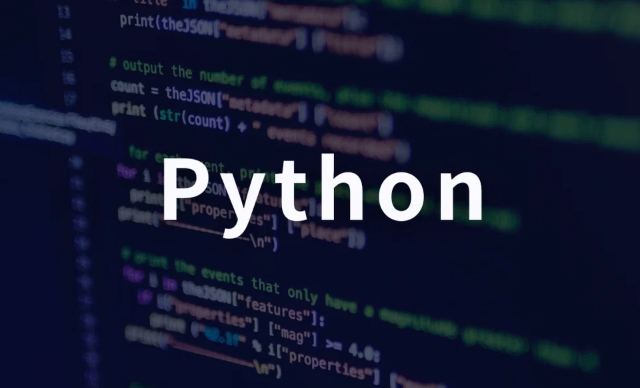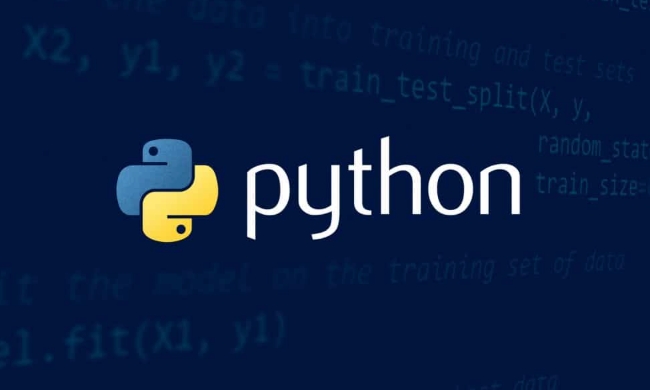The reasons for building data directories in Python include its strong data processing capabilities, rich library support and automation advantages. 1. Python can efficiently extract metadata from databases, file systems and cloud services; 2. Provide flexible data organization methods, such as structured storage and visual display; 3. Support automated update mechanisms to ensure directory timeliness. SQLAlchemy can obtain the database table structure, use pandas or pyarrow to read the file schema, then store it in JSON or database form, and build a query interface with Flask/FastAPI, and combine cron job or Airflow to achieve timed updates, thereby building a complete and dynamically maintained data directory system.

Data Catalog is essentially a searchable list of all data assets in an organization, which helps users quickly find, understand and use the data they need. Building data catalogs in Python is not only flexible and efficient, but also can automate the management of metadata with existing tools and processes.

Why do you need to use Python to build a data directory?
Python is very powerful in data processing and automation, especially suitable for extracting metadata from databases, file systems, and even cloud services. Compared to manually maintaining directories, it is more reliable and faster to automatically crawl information with scripts. In addition, the Python community provides many libraries, such as sqlalchemy , pandas , pyarrow , etc., which can easily connect different data sources and generate unified metadata structures.
How to collect metadata?
The first step in building a data directory is to collect metadata. It can be obtained from the following sources:

- Database table structure : Get field names, types, comments, etc. through SQLAlchemy or the database-owned commands (such as
INFORMATION_SCHEMA). - CSV/Parquet file header information : Use pandas or pyarrow to open the file to read the schema.
- API interface or metadata center : If the company already has a metadata management system, it can be obtained through the API.
Example: Use SQLAlchemy to get column information of a PostgreSQL table
from sqlalchemy import create_engine, MetaData, Table
engine = create_engine('postgresql://user:password@localhost:5432/mydb')
metadata = MetaData(bind=engine)
table = Table('my_table', metadata, autoload=True)
for column in table.columns:
print(column.name, column.type, column.comment)This allows you to get the basic metadata of a table, including field names, types, and possible descriptions.

How to organize and display data catalogs?
With metadata, the next step is to organize them. Usually we store metadata in a structured format, such as JSON or write to a lightweight database (SQLite, PostgreSQL, etc.). Then provide a simple web page or CLI tool to query this information.
Commonly used tools are:
- Flask/FastAPI : used to build a simple web query interface.
- Streamlit/Dash : If you want to make a visual interface, both frameworks are very convenient.
- Markdown Static Page : For small projects, Markdown can be generated directly and deployed as static web pages.
For example, you can use FastAPI to make a search interface:
from fastapi import FastAPI
import json
app = FastAPI()
with open("metadata.json") as f:
catalog = json.load(f)
@app.get("/search")
def search(query: str):
results = [item for item in catalog if query.lower() in item["name"].lower()]
Return results After startup, access /search?q=customer to find the relevant data set.
Automated updates are key
The data directory is not a one-time project, it needs to be updated regularly to reflect the latest data status. It can be run regularly with Python scripts to grab the latest metadata and update the storage.
Implementation methods include:
- Use cron job or Windows Task Scheduler to execute scripts regularly
- Combined with Airflow or Dagster to implement more complex scheduling logic
- Detect file changes and trigger updates (applicable to file systems)
It is recommended to record timestamps at each update and keep historical versions to track changes.
Basically that's it. Building data directories in Python is not complicated but it is easy to ignore details, such as metadata consistency, error handling and permission control, which all need to be gradually improved in actual applications.
The above is the detailed content of Building Data Catalogs with Python. For more information, please follow other related articles on the PHP Chinese website!

Hot AI Tools

Undress AI Tool
Undress images for free

Undresser.AI Undress
AI-powered app for creating realistic nude photos

AI Clothes Remover
Online AI tool for removing clothes from photos.

Clothoff.io
AI clothes remover

Video Face Swap
Swap faces in any video effortlessly with our completely free AI face swap tool!

Hot Article

Hot Tools

Notepad++7.3.1
Easy-to-use and free code editor

SublimeText3 Chinese version
Chinese version, very easy to use

Zend Studio 13.0.1
Powerful PHP integrated development environment

Dreamweaver CS6
Visual web development tools

SublimeText3 Mac version
God-level code editing software (SublimeText3)
 Polymorphism in python classes
Jul 05, 2025 am 02:58 AM
Polymorphism in python classes
Jul 05, 2025 am 02:58 AM
Polymorphism is a core concept in Python object-oriented programming, referring to "one interface, multiple implementations", allowing for unified processing of different types of objects. 1. Polymorphism is implemented through method rewriting. Subclasses can redefine parent class methods. For example, the spoke() method of Animal class has different implementations in Dog and Cat subclasses. 2. The practical uses of polymorphism include simplifying the code structure and enhancing scalability, such as calling the draw() method uniformly in the graphical drawing program, or handling the common behavior of different characters in game development. 3. Python implementation polymorphism needs to satisfy: the parent class defines a method, and the child class overrides the method, but does not require inheritance of the same parent class. As long as the object implements the same method, this is called the "duck type". 4. Things to note include the maintenance
 Explain Python generators and iterators.
Jul 05, 2025 am 02:55 AM
Explain Python generators and iterators.
Jul 05, 2025 am 02:55 AM
Iterators are objects that implement __iter__() and __next__() methods. The generator is a simplified version of iterators, which automatically implement these methods through the yield keyword. 1. The iterator returns an element every time he calls next() and throws a StopIteration exception when there are no more elements. 2. The generator uses function definition to generate data on demand, saving memory and supporting infinite sequences. 3. Use iterators when processing existing sets, use a generator when dynamically generating big data or lazy evaluation, such as loading line by line when reading large files. Note: Iterable objects such as lists are not iterators. They need to be recreated after the iterator reaches its end, and the generator can only traverse it once.
 How to handle API authentication in Python
Jul 13, 2025 am 02:22 AM
How to handle API authentication in Python
Jul 13, 2025 am 02:22 AM
The key to dealing with API authentication is to understand and use the authentication method correctly. 1. APIKey is the simplest authentication method, usually placed in the request header or URL parameters; 2. BasicAuth uses username and password for Base64 encoding transmission, which is suitable for internal systems; 3. OAuth2 needs to obtain the token first through client_id and client_secret, and then bring the BearerToken in the request header; 4. In order to deal with the token expiration, the token management class can be encapsulated and automatically refreshed the token; in short, selecting the appropriate method according to the document and safely storing the key information is the key.
 How to iterate over two lists at once Python
Jul 09, 2025 am 01:13 AM
How to iterate over two lists at once Python
Jul 09, 2025 am 01:13 AM
A common method to traverse two lists simultaneously in Python is to use the zip() function, which will pair multiple lists in order and be the shortest; if the list length is inconsistent, you can use itertools.zip_longest() to be the longest and fill in the missing values; combined with enumerate(), you can get the index at the same time. 1.zip() is concise and practical, suitable for paired data iteration; 2.zip_longest() can fill in the default value when dealing with inconsistent lengths; 3.enumerate(zip()) can obtain indexes during traversal, meeting the needs of a variety of complex scenarios.
 Explain Python assertions.
Jul 07, 2025 am 12:14 AM
Explain Python assertions.
Jul 07, 2025 am 12:14 AM
Assert is an assertion tool used in Python for debugging, and throws an AssertionError when the condition is not met. Its syntax is assert condition plus optional error information, which is suitable for internal logic verification such as parameter checking, status confirmation, etc., but cannot be used for security or user input checking, and should be used in conjunction with clear prompt information. It is only available for auxiliary debugging in the development stage rather than substituting exception handling.
 What are python iterators?
Jul 08, 2025 am 02:56 AM
What are python iterators?
Jul 08, 2025 am 02:56 AM
InPython,iteratorsareobjectsthatallowloopingthroughcollectionsbyimplementing__iter__()and__next__().1)Iteratorsworkviatheiteratorprotocol,using__iter__()toreturntheiteratorand__next__()toretrievethenextitemuntilStopIterationisraised.2)Aniterable(like
 What are Python type hints?
Jul 07, 2025 am 02:55 AM
What are Python type hints?
Jul 07, 2025 am 02:55 AM
TypehintsinPythonsolvetheproblemofambiguityandpotentialbugsindynamicallytypedcodebyallowingdeveloperstospecifyexpectedtypes.Theyenhancereadability,enableearlybugdetection,andimprovetoolingsupport.Typehintsareaddedusingacolon(:)forvariablesandparamete
 Python FastAPI tutorial
Jul 12, 2025 am 02:42 AM
Python FastAPI tutorial
Jul 12, 2025 am 02:42 AM
To create modern and efficient APIs using Python, FastAPI is recommended; it is based on standard Python type prompts and can automatically generate documents, with excellent performance. After installing FastAPI and ASGI server uvicorn, you can write interface code. By defining routes, writing processing functions, and returning data, APIs can be quickly built. FastAPI supports a variety of HTTP methods and provides automatically generated SwaggerUI and ReDoc documentation systems. URL parameters can be captured through path definition, while query parameters can be implemented by setting default values ??for function parameters. The rational use of Pydantic models can help improve development efficiency and accuracy.






